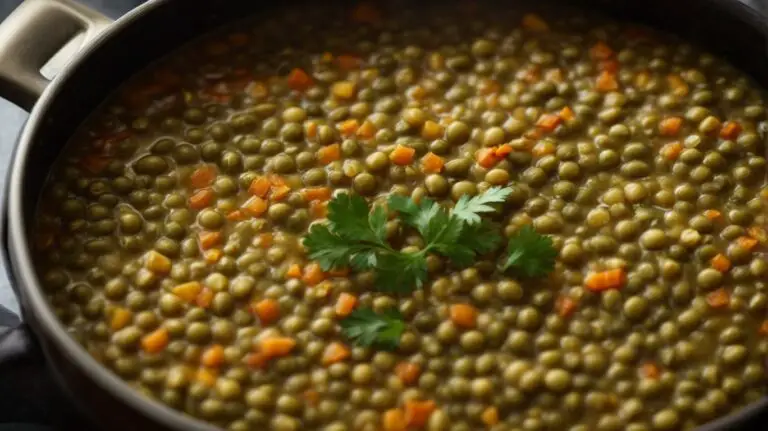How to Cook Egusi Soup?
Looking to add a taste of West Africa to your culinary repertoire?
Discover Egusi Soup! Explore the origins, essential ingredients, and step-by-step process of preparing and cooking this delicious dish. From selecting and cleaning the Egusi seeds to seasoning the soup, get all the tips and tricks you need.
Uncover the secrets to creating a flavorful and satisfying bowl of this traditional African dish. Get ready to enjoy Egusi Soup!
Key Takeaways:
What is Egusi Soup?
Egusi Soup, a traditional West African dish originating from Nigeria, is a flavorful and nutritious soup made with melon seeds and an array of delicious ingredients.
This hearty soup holds a revered spot in Nigerian cuisine, often gracing dining tables during special occasions and everyday meals. Known for its rich flavors and creamy texture, Egusi Soup is a staple dish that represents the culinary heritage of Nigeria.
The process of preparing this beloved soup involves grinding melon seeds into a fine powder and then simmering them with vegetables, meats, and spices to create a savory blend that delights the taste buds.
Origin of Egusi Soup
The Origin of Egusi Soup can be traced back to West Africa, particularly Nigeria, where it holds a special place in the culinary traditions of the region.
Egusi Soup, known for its rich history and cultural significance, reflects the diverse flavors and ingredients found in West African cuisine. This hearty dish, traditionally made with ground melon seeds, palm oil, leafy greens, and various spices, showcases the vibrant culinary heritage of Nigeria. Over the years, Egusi Soup has evolved to include different regional variations and adaptations, with each recipe telling a unique story of local tastes and preferences. From celebratory feasts to everyday meals, this flavorful soup plays a pivotal role in the gastronomic landscape of West Africa.
Ingredients for Egusi Soup
The Ingredients for Egusi Soup include a rich blend of vegetables, meats, palm oil, crayfish, and aromatic condiments that come together to create a harmonious and flavorful dish.
One of the key elements in making a delicious Egusi Soup is the choice of vegetables. Commonly used vegetables include bitter leaf, spinach, or pumpkin leaves, which add both flavor and nutrients to the dish. The selection of meats such as chicken, beef, or fish contributes to the heartiness and protein content of the soup. The use of palm oil not only imparts a rich color to the soup but also enhances its distinctive taste. The inclusion of traditional seasonings like locust beans and ground pepper adds depth and spice to the overall flavor profile of the soup.
How to Prepare the Egusi?
Preparing Egusi involves selecting, cleaning, blending, and frying the seeds to achieve the desired texture and flavor profile essential for the soup.
Start by carefully examining the Egusi seeds, opting for the ones that are well-dried and free from any impurities. After selection, wash the seeds thoroughly to remove any dust or debris.
Next, place the seeds in a blender and grind them into a fine paste consistency, adding a little water as needed. Once blended, transfer the Egusi paste into a heated pan with oil, and fry it until it releases its nutty fragrance, intensifying the overall taste of the soup.
Selecting and Cleaning the Egusi Seeds
Selecting and Cleaning Egusi Seeds is a crucial initial step in preparing Egusi Soup, ensuring that the seeds are free from impurities and ready for blending.
When choosing Egusi seeds for your soup, opt for high-quality ones that are fresh and free from any molds or discoloration. To clean the seeds, start by sorting through them to remove any debris or foreign particles. Next, place the seeds in a bowl filled with clean water and allow them to soak for a few minutes. Gently rub the seeds between your hands to loosen any dirt, then rinse them thoroughly under running water to ensure they are completely clean.
After cleaning, spread the seeds on a clean cloth or paper towel to dry. This step is essential before blending the Egusi seeds to prevent moisture from affecting the texture of your soup. Once the seeds are dry, they are ready to be ground into a fine powder for use in your delicious Egusi Soup.
Blending the Egusi Seeds
Blending Egusi Seeds into a smooth paste is a crucial step in creating the base for Egusi Soup, ensuring a creamy and flavorful consistency.
When blending Egusi seeds, it is essential to start with high-quality, fresh seeds to achieve the best results. These seeds are rich in oil and protein, giving the soup its distinctive nutty flavor.
To create a thick and creamy paste, the seeds are typically ground or crushed into a fine powder before mixing with water or broth. This process not only enhances the flavor but also helps thicken the soup to the desired consistency. Some chefs may roast the seeds before blending to intensify their nutty aroma and taste.
Frying the Egusi Seeds
Frying Egusi Seeds in palm oil releases a rich aroma and enhances the nutty flavor, adding depth and complexity to the Egusi Soup.
This traditional cooking method involves heating palm oil until it shimmers, then adding the Egusi Seeds to toast them to a golden hue. The crackling sound as they hit the hot oil signifies the beginning of the transformation process.
As the seeds fry, their natural oils infuse the oil, creating a fragrant base that forms the backbone of the dish’s flavor profile. The aroma that wafts through the kitchen is a tantalizing mix of earthy tones and nuttiness, drawing in anyone nearby.
How to Cook Egusi Soup?
Cooking Egusi Soup involves a series of steps that include preparing the stock, adding blended Egusi seeds, vegetables, and seasoning to create a rich and hearty dish.
In Nigerian cuisine, Egusi Soup is a staple dish known for its smooth, thick texture and nutty flavor. To begin the culinary journey, one should focus on creating a flavorful stock using assorted meats or fish, onions, and seasonings like salt and bouillon cubes.
Once the stock is simmering, the Egusi seeds are ground into a paste, which will serve as the base for the soup. This paste is then added to the stock, thickening the liquid and infusing it with a creamy consistency.
As the soup cooks, vibrant vegetables such as spinach, bitter leaf, or pumpkin leaves are incorporated, adding a burst of color and nutrients to the dish. Seasonings like crayfish, dried fish, and palm oil are also included to elevate the flavors.
Preparing the Stock
Preparing the Stock for Egusi Soup involves simmering meats and vegetables to extract their flavors and create a robust base for the soup.
The process of simmering the meats and vegetables is a crucial step in stock preparation as it allows the ingredients to release their savory essences into the liquid. By gently cooking them over low heat, the flavors slowly infuse, resulting in a rich and aromatic broth that will serve as the foundation of your Egusi Soup.
This slow cooking process not only extracts the flavors but also helps to tenderize the meats, ensuring they are melt-in-your-mouth tender when added back to the soup. A well-made stock is the secret to a truly delicious and satisfying Egusi Soup.
Adding the Blended Egusi Seeds
Adding the Blended Egusi Seeds to the simmering stock creates a creamy and hearty mixture that forms the essence of Egusi Soup.
As the blended Egusi seed paste is gently stirred into the bubbling stock, a magical transformation begins to take place. The rich seeds disperse their nutty aroma, infusing the liquid with a depth of flavor that is unmatched. Slowly simmering, the mixture thickens, creating a luscious and velvety texture that coats the back of a spoon. The soup starts to develop a distinct earthy taste, melding perfectly with any added vegetables or proteins. The Egusi seeds, finely ground and blended, act as a natural thickening agent, creating a luxurious soup base that is both hearty and comforting.
Adding the Vegetables and Other Ingredients
Adding the Vegetables and Other Ingredients such as spinach, pepper, and onions elevates the flavor profile of Egusi Soup, creating a well-balanced and nutritious dish.
Regarding incorporating vegetables into Egusi Soup, choosing fresh produce is paramount. Opt for vibrant green spinach, which not only adds a pop of color but also contributes essential nutrients like iron and vitamins. Onions, with their aromatic flavor, serve as a flavorful base for the soup, while peppers provide a subtle heat and depth of flavor.
For a harmonious blend of flavors, sautéing the vegetables in a mix of seasonings like garlic, ginger, and traditional African spices adds complexity to the soup. The combination of these ingredients not only enhances the taste but also boosts the nutritional value of the dish, making it a wholesome and satisfying option.
Cooking and Seasoning the Soup
Cooking and Seasoning the Egusi Soup involves simmering the ingredients to meld flavors and adding salt, stock cubes, and other condiments to achieve the perfect balance of taste.
During the final stages of cooking Egusi Soup, the simmering process is crucial as it allows all the flavors from the vegetables, meat, and spices to blend together harmoniously. Properly simmering the soup ensures that the ingredients are thoroughly cooked and that the flavors have time to intensify. The addition of salt,, stock cubes,, and other seasonings is essential to enhance the overall taste of the soup, bringing out the richness of the ingredients. Seasoning not only adds flavor but also helps to bring out the natural umami in the dish, creating a well-balanced and delicious final product.
Tips for Making the Perfect Egusi Soup

Credits: Poormet.Com – William Miller
Crafting the Perfect Egusi Soup requires attention to detail, fresh ingredients, proper water quantities, and precise blending and vegetable addition techniques.
Regarding the blending process, ensuring your Egusi seeds are ground to a fine consistency is key to achieving that rich, creamy texture. Use a high-quality blender or grinder to achieve the desired smoothness. Incorporating vegetables like spinach or bitter leaf can elevate the flavor profile of your Egusi Soup.
Using Fresh Ingredients
Using Fresh Ingredients is key to achieving the best flavors in Egusi Soup, ensuring that the vegetables and meats contribute their vibrant essence to the dish.
Regarding Egusi Soup, the quality of the ingredients can make or break the dish. Fresh vegetables like spinach, bitterleaf, and pumpkin leaves bring a burst of color, nutrients, and flavor to the soup. Their natural essence infuses into the broth, creating a tantalizing aroma and a rich taste that lingers on the palate. High-quality meats, such as goat, chicken, or beef, add depth and texture to the dish, making each spoonful a delightful experience. These fresh ingredients not only elevate the taste but also enhance the overall nutritional value of the soup, making it a wholesome and satisfying meal.
Using the Right Amount of Water
Using the Right Amount of Water is crucial for achieving the desired consistency and texture in Egusi Soup, balancing moisture levels to create a satisfying dish.
Adding water gradually in the cooking process is essential to prevent the Egusi Soup from becoming too watery or too thick.
The quantity of water added depends on personal preference but generally, measuring out the liquid and adjusting as needed is a good practice.
Too much water can dilute the flavors, while too little can lead to a dry, unappetizing consistency.
The right amount of water can impact the cooking duration, with more water potentially requiring a longer simmering time to achieve the ideal flavors.
Properly Blending the Egusi Seeds
Properly Blending the Egusi Seeds into a smooth paste is essential for achieving the desired texture and flavor balance in Egusi Soup, ensuring a velvety consistency.
Regarding preparing Egusi Soup, the technique of properly blending the Egusi seeds can make a significant difference in elevating the dish to a whole new level of gourmet perfection. The process of blending the seeds to just the right texture can be both an art and a science, requiring finesse and precision. One key tip is to soak the Egusi seeds in water before blending to soften them and aid in achieving a smooth paste.
Many traditional recipes recommend using a blender to grind the Egusi seeds, ensuring a fine and consistent texture. Some chefs prefer the traditional mortar and pestle method for a more rustic and authentic touch, allowing for a coarser texture that adds depth to the soup.
Another crucial aspect of blending Egusi seeds is to avoid over-processing, as this can result in a gritty or gritty mouthfeel in the final dish. By achieving the perfect balance between blending time and technique, you can create a luxurious, creamy paste that binds all the flavors together harmoniously.
Adding the Vegetables at the Right Time
Adding the Vegetables at the Right Time during the cooking process ensures that they retain their texture, color, and flavor, enhancing the overall appeal of Egusi Soup.
Timing plays a crucial role in maintaining the freshness, nutrients, and flavors of vegetables in Egusi Soup. Vegetables are delicate and can easily lose their vibrant colors and vital nutrients if overcooked. By adding them at the right moment, you can preserve their crunchiness and nutritional value, ensuring a delightful culinary experience.
In terms of sequence, start with tougher vegetables like carrots and peppers, adding leafy greens and herbs towards the end for maximum freshness. Be mindful not to overcook them; a few minutes are usually sufficient to let the flavors meld together.
Conclusion

Credits: Poormet.Com – Eric Ramirez
In conclusion, Egusi Soup stands as a beloved West African culinary delight that combines rich flavors, nutritious ingredients, and cultural heritage in a single wholesome dish.
Originating from various West African countries including Nigeria, Ghana, and Cameroon, Egusi Soup plays a significant role in traditional ceremonies and everyday dining. The dish typically features ground melon seeds as its base, creating a thick, creamy texture when cooked with a flavorful blend of spices, vegetables, and proteins such as meat or fish. The meticulous preparation involves soaking and grinding the seeds, followed by slow cooking to allow the flavors to meld perfectly.
The versatility of Egusi Soup extends beyond its cultural roots, capturing the attention of food enthusiasts worldwide with its depth of flavors and nutrient-rich profile. Its universal appeal lies in the harmonious balance of savory, earthy, and aromatic notes, making it a valuable addition to global culinary diversities.







